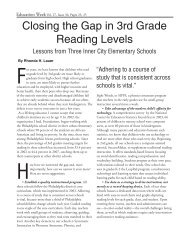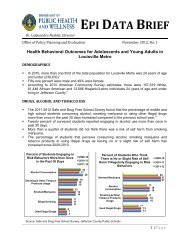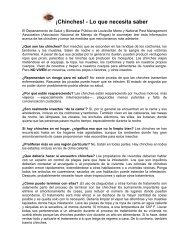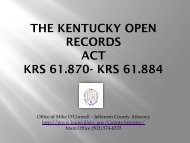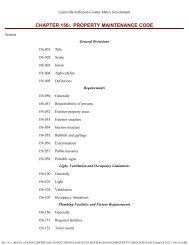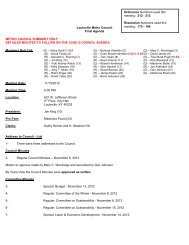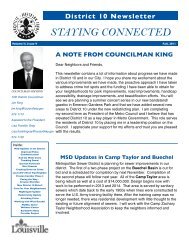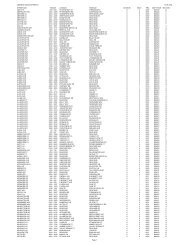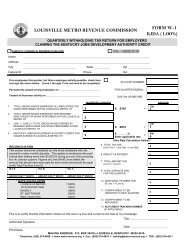Cultural History of Charlie Vettiner Park - Louisville Metro Government
Cultural History of Charlie Vettiner Park - Louisville Metro Government
Cultural History of Charlie Vettiner Park - Louisville Metro Government
You also want an ePaper? Increase the reach of your titles
YUMPU automatically turns print PDFs into web optimized ePapers that Google loves.
<strong>Cultural</strong> <strong>History</strong> <strong>of</strong> <strong>Charlie</strong> <strong>Vettiner</strong> <strong>Park</strong><br />
included ―Al Jolson, Lana Turner, Babe Ruth, and Jack Dempsey‖. Although the interurban line<br />
ceased in 1933, the hotel remained open until 1962.<br />
Hikes Point. Hikes Point lies in an area that was settled in 1791 by George Hikes, a<br />
Revolutionary War veteran. Hikes was born thirty years previous in Lancaster County,<br />
Pennsylvania. He moved to Jefferson County on land he purchased from William Meriwether,<br />
after serving in the Revolutionary War with James Cook's Company <strong>of</strong> Fourth Battalion <strong>of</strong> Militia.<br />
He was married to Barbara Oleweiler, and had four sons: John, Jacob, Andrew, and George<br />
and three daughters. Hikes built and operated grist and saw mills as the community developed.<br />
In addition, a cloth industry developed in the early 1800s.<br />
Hikes built several homes on his land in eastern Jefferson County. These include a stone home<br />
named Two Mile Town. The structure that is now occupied by St. Michael's Antioch Church is<br />
one <strong>of</strong> the original stone houses <strong>of</strong> the Hikes Family. A small family cemetery is located along<br />
Hikes Lane on the grounds <strong>of</strong> this house. Later this structure was willed to Andrew Hikes,<br />
George's youngest son (Jefferson Count, Kentucky Will Book 2, page 484.) Another <strong>of</strong> the<br />
extant original Hikes family houses is currently occupied by John E's Restaurant at the corner <strong>of</strong><br />
Bardstown Road and Hikes Lane that opened in the 1980s. This structure incorporates a<br />
nineteenth century log cabin. Portions <strong>of</strong> the log walls have been covered with plaster, but some<br />
are exposed and can still be seen. A larger Hikes family cemetery lies to the south side <strong>of</strong> the<br />
building.<br />
The early 1900s saw development claim much <strong>of</strong> the land surrounding the Hikes homesteads.<br />
This accelerated after World War II. Roy McMahan purchased the Eberle family farm in the area<br />
in 1946 and built several subdivisions and shopping centers. Since that time, Hikes Point has<br />
long been a strong retail area (Wikipedia, accessed January 2009).<br />
Fisherville is an unincorporated town situated along the banks <strong>of</strong> Floyd‘s Fork in<br />
eastern Jefferson County. It was settled in the early nineteenth century primarily by farmers<br />
from Virginia and Pennsylvania. The town was originally called Curreys (around 1833) after the<br />
first postmaster, Edward Currey. The town was renamed for Robert Fisher 1 in 1845 or 1847<br />
(Rennick 1984:101; Kleber 2001:293). Robert, along with his father John Fisher, came to the<br />
area in 1835 and established a five-story grist mill (archaeological site 15JF551) as well as a<br />
sawmill (historic structure JF672) along the banks <strong>of</strong> Floyd‘s Fork (Meyer et al. 2007). The mill<br />
was razed in 1920, and its timbers used to construct a livery stable (Runyon 1989:46).<br />
The development <strong>of</strong> the small community was similar to other ―stringtowns‖. Settlement<br />
occurred along a three quarters <strong>of</strong> a mile stretch on Old Taylorsville Road where it crossed<br />
Floyd‘s Fork between English Station Road and Fisherville Road. One half <strong>of</strong> the town<br />
contained the business, while the residential areas lay in the other (Kleber 2001:293). However,<br />
the Fisher mill was the most important commercial and industrial establishment along Floyds<br />
Fork, and the success <strong>of</strong> the Fisher milling operation and the economic vitality <strong>of</strong> Fisherville<br />
were directly linked for almost three quarters <strong>of</strong> a century (Meyer et al. 2007).<br />
Of interest to this investigation, Peter Smith acquired Robert Fisher‘s mill in 1864 and later sold<br />
the property to Henry Smith (Meyer et al. 2007). The Smiths were a prominent local family, and<br />
almost certainly related to the family interred in Shakes Run Cemetery. In 1874, Smith sold the<br />
Fisherville mill property out <strong>of</strong> the Smith family. It was purchased by Stephen Beard, who<br />
1 Some sources say Richard Fisher (Meyer et al. 2007).<br />
32 | P a g e



